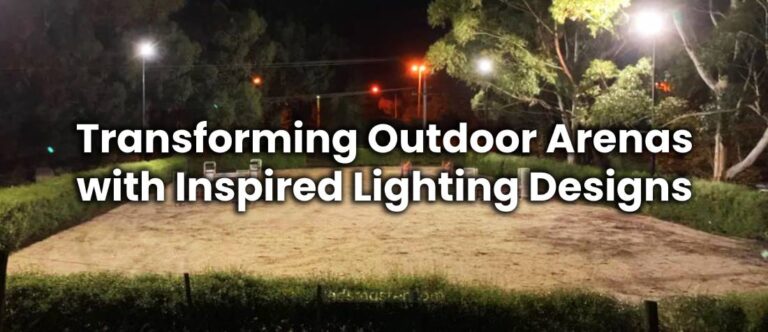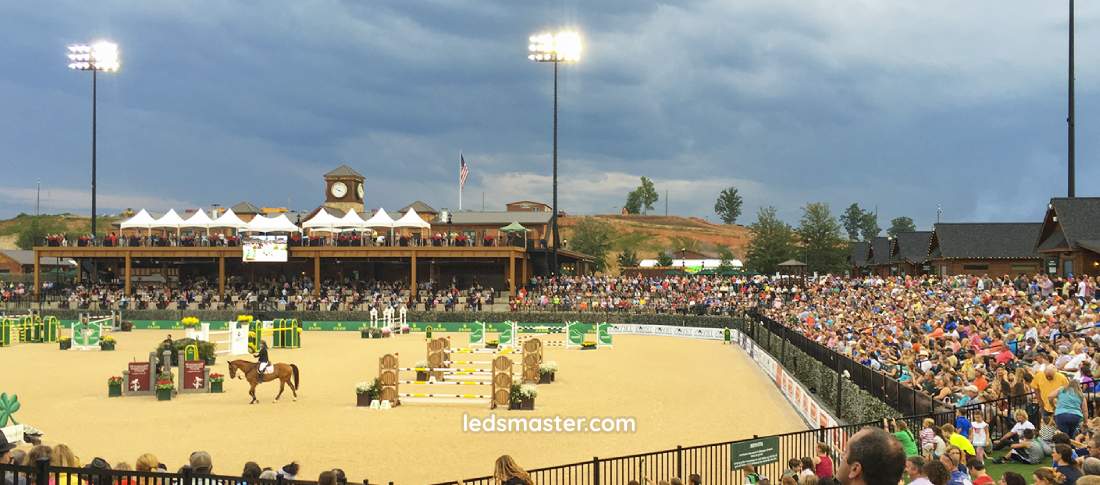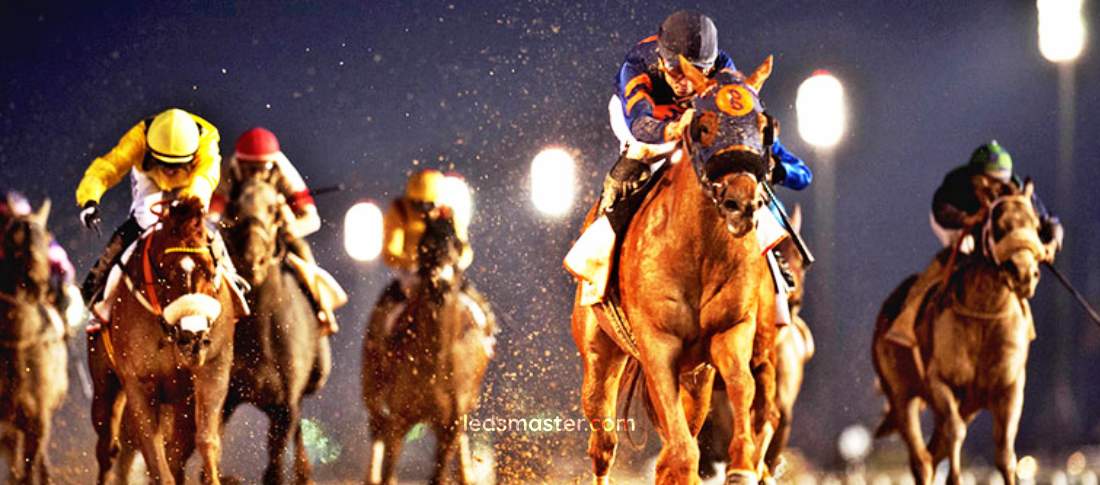
The right lighting transforms an outdoor horse arena into a captivating space where riders and horses can perform at their best, even after the sun sets. With perfectly placed lights casting a warm glow over the arena, every jump, trot, and gallop comes to life under the night sky. Thoughtfully designed lighting not only illuminates the path but creates a safe, inviting atmosphere for unforgettable equestrian experiences.
Get your complimentary lighting design today
Creating the right lighting design for an outdoor horse arena is key to ensuring that both horses and riders enjoy optimal visibility and safety during evening or nighttime riding. A well-planned lighting system allows for various equestrian activities such as training, competitions, and leisurely rides while maintaining visual comfort for participants and reducing strain on the horses. Designing effective lighting for outdoor arenas involves choosing the appropriate type of lighting, proper placement of fixtures, and considering factors such as pole height, uniformity, and overall safety.
Table of Contents
ToggleChoosing the right type of lighting for an outdoor horse arena depends on factors like arena size, the level of activity taking place, energy efficiency, and durability. Different types of lighting offer various benefits, so understanding the options available helps in making the best selection.
LED lighting has become a popular choice for outdoor horse arenas due to its energy efficiency and long lifespan. LEDs are known for providing bright, clear illumination, which is especially valuable during evening rides or competitions. In addition, LED fixtures have a longer operational life compared to traditional lights, reducing maintenance and replacement costs over time. Another benefit of LEDs is their ability to produce uniform light distribution, minimizing dark spots across the arena. This feature enhances both visibility and safety for riders and horses.

Metal halide lighting offers a high-intensity option with broad beam coverage, making it suitable for large arenas. These lights are often preferred for equestrian events that require excellent visibility over a wide area. While metal halide lamps deliver bright light, they consume more energy compared to LEDs and have a shorter lifespan. However, for arenas where extreme brightness is required, metal halide lights can still be a viable option.
Halogen lights are less commonly used in modern outdoor arenas due to their lower efficiency and higher energy consumption. However, they remain an option for smaller arenas or temporary setups because of their affordability. Halogen lights produce a warm, natural glow, but they tend to generate more heat, which may lead to higher operating costs over time.
Solar-powered lighting is an eco-friendly option for outdoor horse arenas. These systems utilize solar panels to store energy during the day and power the lights at night. Solar-powered lights reduce the arena’s carbon footprint and are a great choice for arenas located in areas with abundant sunlight. While solar systems offer the advantage of lower operating costs, they may require larger initial investments and periodic maintenance to ensure optimal performance.
Designing an effective lighting system for an outdoor horse arena requires attention to several factors that ensure proper illumination without causing discomfort or hazards for horses and riders. These considerations involve determining the appropriate brightness level, maintaining uniform light distribution, and choosing the right color temperature.
The size and layout of the arena heavily influence the number and placement of lights. A rectangular arena, for example, may require a different lighting configuration compared to a circular or irregularly shaped arena. Designers should account for the arena’s dimensions when deciding where to place lights and how many fixtures are needed to cover the entire space without leaving any areas under-lit.
Lux levels, which measure the amount of light on a surface, are a critical aspect of lighting design. The appropriate lux level depends on the type of activity taking place in the arena. For example, arenas used primarily for recreational riding may require lower lux levels than those used for professional competitions or training. Too much light can cause discomfort for horses, while too little light can compromise safety. Designers typically aim for lux levels that balance visibility with comfort, ensuring that both horses and riders can perform at their best.
Uniform light distribution is key to avoiding dark spots or overly bright areas within the arena. Uneven lighting can lead to visual discomfort for riders and distractions for horses, as sudden changes in brightness can be disorienting. To maintain uniformity, lights should be positioned strategically around the arena, with overlapping beams to eliminate shadows and ensure even illumination throughout the space.
The color temperature of the lighting affects how well riders can see and how comfortably horses move within the arena. Lighting with a higher color temperature (between 5000K and 6000K) tends to produce a cooler, daylight-like tone, which reduces glare and enhances visual clarity. This cooler light is particularly useful during nighttime events or in areas where precise visibility is needed. Warmer color temperatures (below 4000K), while providing a softer light, may not be as effective for arenas that require clear, focused lighting.
The height of the light poles plays a significant role in determining the effectiveness of an outdoor horse arena lighting system. Proper pole height ensures that the light is distributed evenly across the arena without creating harsh shadows or overly bright spots.
When selecting the appropriate pole height, several factors come into play, including the size of the arena and the intensity of the light fixtures. Taller poles help to spread the light more evenly over larger areas, reducing the risk of shadows that may obstruct the rider’s or horse’s vision. For smaller arenas, shorter poles may suffice, but attention must still be paid to ensuring that the light coverage remains uniform.
Pole height directly impacts the light distribution pattern. For example, if the poles are too low, the light beams may concentrate too much on certain areas, creating bright spots while leaving other sections under-lit. Conversely, poles that are too high can cause the light to become dispersed too widely, reducing the intensity of the illumination and potentially leading to darker areas. Striking the right balance between pole height and light fixture intensity ensures that the arena is consistently well-lit, promoting both visibility and safety.
The safety and comfort of both horses and riders are paramount when designing a lighting system for an outdoor arena. Proper lighting minimizes the risk of accidents and ensures that both horses and riders can perform confidently, even in low-light conditions.

Glare can be a significant issue in outdoor arenas, as excessive brightness can cause visual discomfort for both riders and horses. Horses, in particular, have sensitive eyes and may react unpredictably to intense light. To prevent glare, it is important to choose lighting fixtures that distribute light evenly without creating overly bright spots. Shielded fixtures, designed to direct the light downward and reduce horizontal glare, are often used in equestrian lighting systems.
Flickering lights can be both distracting and disorienting for horses and riders. Horses may become unsettled by inconsistent lighting, while riders may experience difficulty maintaining their focus in a flickering environment. High-quality LED lighting systems are designed to be flicker-free, ensuring a smooth and consistent lighting experience that promotes a sense of calm and focus for all participants in the arena.
Light spill occurs when light extends beyond the intended area, illuminating areas outside the arena, such as nearby roads or properties. This can not only be a nuisance to neighbors but also reduce the effectiveness of the lighting within the arena. Preventing light spill is achieved by using lighting fixtures that focus the beam of light specifically within the arena’s boundaries. Additionally, adjustable lighting allows operators to fine-tune the light’s direction, ensuring it stays concentrated where it is needed most.
Clear visibility is key for riders to confidently maneuver their horses, especially during fast-paced or intricate activities such as jumping or dressage. Inconsistent or inadequate lighting can lead to riders misjudging distances or obstacles, increasing the risk of accidents. By ensuring that the arena is uniformly lit with an appropriate lux level, riders can maintain full control of their horses and navigate the arena with ease.
Horses are highly sensitive to their environment, and the lighting design in an arena can significantly impact their behavior and performance. Bright, harsh lighting can cause horses to become anxious or hesitant, affecting their performance and creating safety concerns. On the other hand, low-level lighting that fails to illuminate the arena sufficiently can also create challenges, as horses may struggle to see obstacles or changes in terrain. A balanced lighting system, designed with the needs of the horse in mind, ensures that the animals remain calm and focused, leading to a more enjoyable experience for both horse and rider.
Professional installation is recommended for outdoor horse arenas, as improper setup can lead to uneven lighting or malfunctioning fixtures. Regular maintenance of the lighting system is also important to keep it functioning optimally over time.
During the installation process, it is crucial to ensure that all fixtures are positioned correctly and securely mounted to prevent issues such as pole instability or misaligned lighting. Wiring should be handled by professionals with experience in outdoor lighting to ensure that the system is weatherproof and safe for long-term use. Additionally, testing the lighting system after installation ensures that it meets the arena’s specific lighting requirements and provides even illumination across the entire space.
Ongoing maintenance is necessary to ensure the longevity and performance of the lighting system. This includes regularly inspecting the fixtures for signs of wear, cleaning lenses to remove dirt or debris that may reduce light output, and replacing any burnt-out bulbs or malfunctioning components. Well-maintained lighting ensures that the arena remains safe and usable year-round, even in harsh weather conditions.
Arenas with older lighting systems, such as those using metal halide or halogen lamps, may benefit from upgrading to modern LED fixtures. LED systems offer better energy efficiency, reduced maintenance, and improved lighting quality, making them a smart choice for arenas looking to improve their lighting without significantly increasing operational costs. An upgrade can also help in minimizing light pollution and improving the overall safety and performance of the lighting system.
Designing an outdoor horse arena lighting system requires careful consideration of the type of lighting, placement, pole height, and ensuring safety and comfort for both horses and riders. Each aspect of the design plays a key role in achieving the desired level of visibility, reducing glare, and maintaining uniform light distribution throughout the arena. By selecting the right fixtures and planning an effective lighting layout, arena operators can create a safe and enjoyable environment for equestrian activities under any lighting conditions.